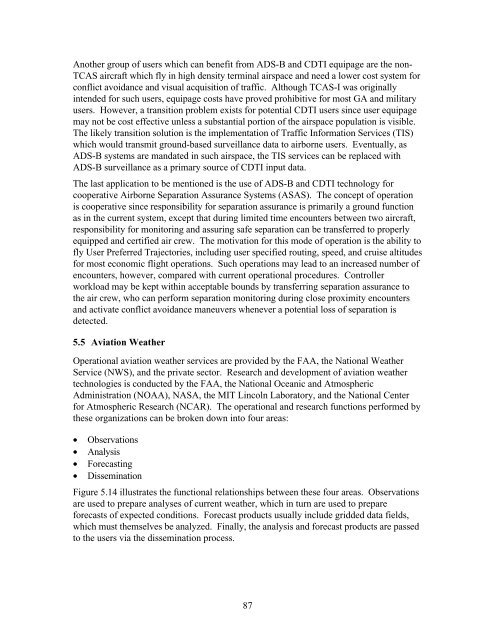Air Traffic Management Concept Baseline Definition - The Boeing ...
Air Traffic Management Concept Baseline Definition - The Boeing ...
Air Traffic Management Concept Baseline Definition - The Boeing ...
You also want an ePaper? Increase the reach of your titles
YUMPU automatically turns print PDFs into web optimized ePapers that Google loves.
Another group of users which can benefit from ADS-B and CDTI equipage are the non-<br />
TCAS aircraft which fly in high density terminal airspace and need a lower cost system for<br />
conflict avoidance and visual acquisition of traffic. Although TCAS-I was originally<br />
intended for such users, equipage costs have proved prohibitive for most GA and military<br />
users. However, a transition problem exists for potential CDTI users since user equipage<br />
may not be cost effective unless a substantial portion of the airspace population is visible.<br />
<strong>The</strong> likely transition solution is the implementation of <strong>Traffic</strong> Information Services (TIS)<br />
which would transmit ground-based surveillance data to airborne users. Eventually, as<br />
ADS-B systems are mandated in such airspace, the TIS services can be replaced with<br />
ADS-B surveillance as a primary source of CDTI input data.<br />
<strong>The</strong> last application to be mentioned is the use of ADS-B and CDTI technology for<br />
cooperative <strong>Air</strong>borne Separation Assurance Systems (ASAS). <strong>The</strong> concept of operation<br />
is cooperative since responsibility for separation assurance is primarily a ground function<br />
as in the current system, except that during limited time encounters between two aircraft,<br />
responsibility for monitoring and assuring safe separation can be transferred to properly<br />
equipped and certified air crew. <strong>The</strong> motivation for this mode of operation is the ability to<br />
fly User Preferred Trajectories, including user specified routing, speed, and cruise altitudes<br />
for most economic flight operations. Such operations may lead to an increased number of<br />
encounters, however, compared with current operational procedures. Controller<br />
workload may be kept within acceptable bounds by transferring separation assurance to<br />
the air crew, who can perform separation monitoring during close proximity encounters<br />
and activate conflict avoidance maneuvers whenever a potential loss of separation is<br />
detected.<br />
5.5 Aviation Weather<br />
Operational aviation weather services are provided by the FAA, the National Weather<br />
Service (NWS), and the private sector. Research and development of aviation weather<br />
technologies is conducted by the FAA, the National Oceanic and Atmospheric<br />
Administration (NOAA), NASA, the MIT Lincoln Laboratory, and the National Center<br />
for Atmospheric Research (NCAR). <strong>The</strong> operational and research functions performed by<br />
these organizations can be broken down into four areas:<br />
• Observations<br />
• Analysis<br />
• Forecasting<br />
• Dissemination<br />
Figure 5.14 illustrates the functional relationships between these four areas. Observations<br />
are used to prepare analyses of current weather, which in turn are used to prepare<br />
forecasts of expected conditions. Forecast products usually include gridded data fields,<br />
which must themselves be analyzed. Finally, the analysis and forecast products are passed<br />
to the users via the dissemination process.<br />
87
















